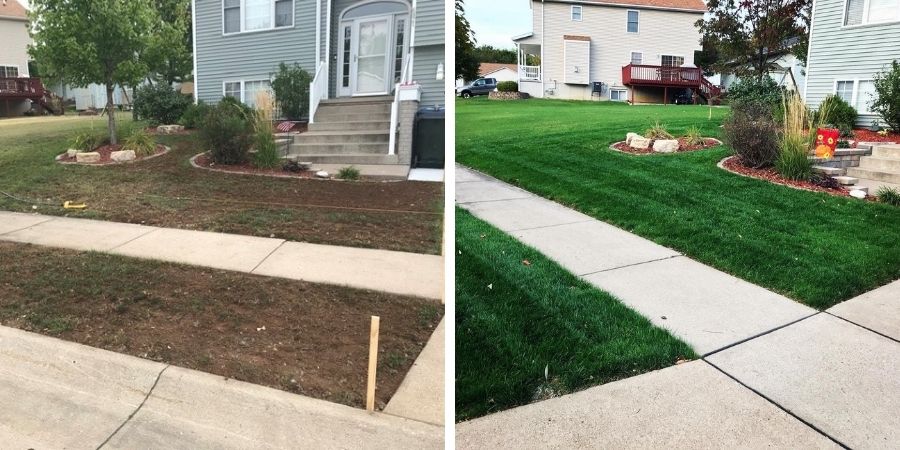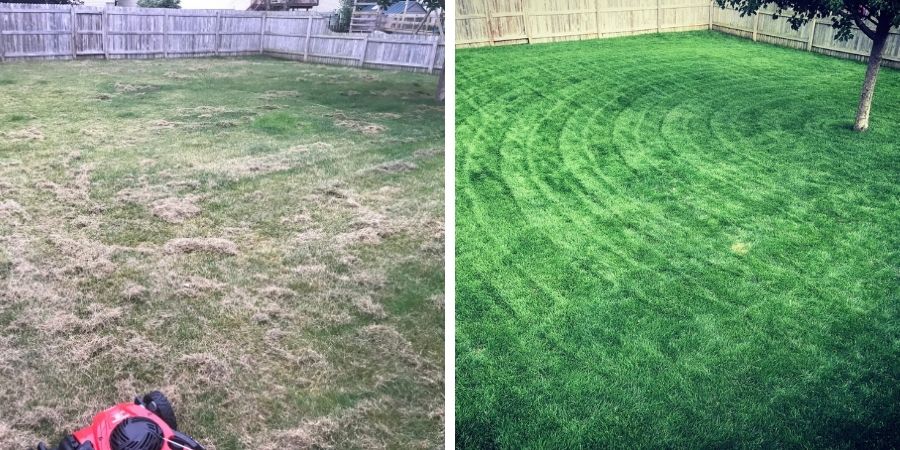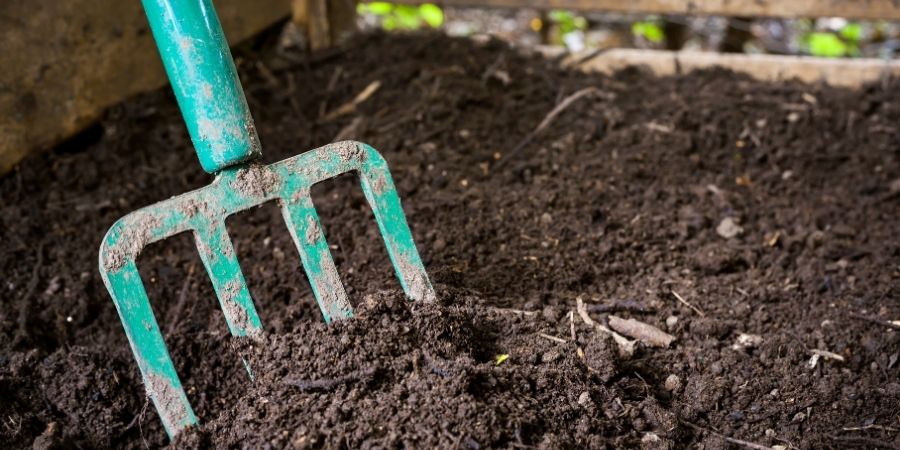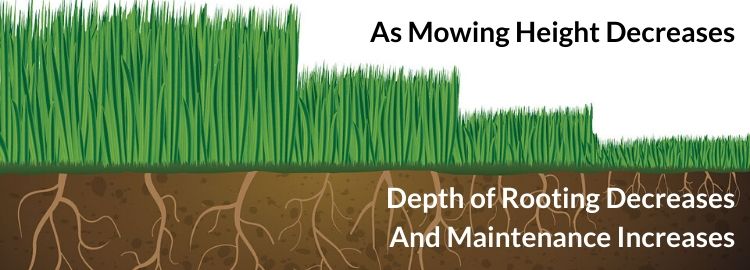Spring Lawn Care for Beginners
- Milorganite AgronomistApril 10, 2021
Nobody is born a lawn care expert. I certainly wasn’t! We all start out as a beginner.
Learning about lawn care is like an apprenticeship—you learn about lawn care by doing lawn care. I’ll share some of the top spring lawn maintenance tips you can use to work your way up from lawn care novice to expert—at least in your neighborhood. You’ll have a house with a beautiful lawn. You have to start somewhere, so don’t be afraid of doing something wrong. You learn by doing. Read on to learn how one homeowner redid his lawn and other tips on how you can take care of your lawn this spring.
Lawn Care Beginner Quickly Advances
Robert W., of Davenport, Iowa, recently shared his lawn care story with Milorganite of his quick ascent from lawn care novice to an intermediate level of lawn care knowledge in less than two years.
 Robert front lawn before and after
Robert front lawn before and after
He and his wife purchased a new home with a yard that’s larger than the one at their previous home of 12 years. “Originally, the lawn at the new house was probably a one out of 10—crabgrass, broadleaf weeds, bare spots— and it wasn’t green.” His new lawn needed some serious care to bring it back.
When asked, Robert rated his DIY lawn-care knowledge as a six or seven out of 10. This is up from a much lower, self-ascribed score only two years ago at the old house.
Robert renovated his lawn this past year. “I sprayed for weeds, dethatched, aerated, overseeded bare spots, and fertilized a couple of times in fall. I’m just trying to keep the lawn weed-free. Keeping the lawn looking good keeps the neighborhood looking good and helps with property values.” Many of the tasks Robert completed are more advanced than a typical beginner may want to deal with. I’ll address them in future posts.
Find a Reliable Source of Lawn Care Information that Works for You
While searching for lawn care tips for beginners, Robert discovered Allyn Hane, The Lawncare Nut and Milorganite partner.
“I didn’t know much about lawn care and I needed a plan. Allyn made things so simple. It doesn’t matter if you’re a novice or a pro, he explains things in steps so the average Joe understands. He keeps it fun. My knowledge and confidence grew exponentially after watching hours of his videos. My lawn care knowledge quickly went from a one to a seven.”
 Robert's backyard before and after
Robert's backyard before and after
Robert can also find a wealth of reliable information from his local extension service, which is staffed by individuals knowledgeable about lawn care, as well as perennials, annuals, shrubs, and trees. They can provide information on horticultural challenges and practices specific to his area.
The Milorganite website offers university-backed lawn care information and best practices for beginners, as well as those higher up on the skills ladder. Milorganite Partner, Melinda Myers, is a well-respected horticultural expert with down-to-earth information for maintaining your entire yard and garden, and Joe Lamp'l, the creator, host, and Executive Producer of Growing a Greener World® and one of the country’s most trusted personalities in gardening and sustainability shares his love and knowledge of soil and his top five steps for an organic lawn.
When to Start Spring Lawn Care
When you start spring lawn care is just as important as what you do. In many areas of the country, melting snow and spring rain are saturating the soil. Here’s an easy test to determine if it’s time to start working on your lawn.
Grab a handful of wet soil. Squeeze it hard. If water runs or even drips from the compressed soil, it’s too soon to start working on the lawn. Consider how much pressure you just used to squeeze water out of the soil. Now imagine your full weight compacting wet soil from walking on your lawn. The soil is going to be compressed significantly. Compacted soil makes it difficult for tender spring grass to grow and inhibits water, air, and nutrients from reaching the roots.
Keep testing until you can’t squeeze any water out of a handful of soil, then you know it’s time to start working on your lawn.
Soil Tests Determine Nutrients and Supplements Your Soil Needs to Feed the Lawn
If you’re new to lawn care, I recommend you first have your soil analyzed. Soil test results will indicate what nutrients and supplements your lawn needs and how much. Applying unnecessary nutrients to your lawn can lead to disease issues and nutrient runoff, which is damaging to the environment, and it’s a waste of money.
Robert chose to pass on having his soil tested. He didn’t feel it was necessary when working on a struggling lawn. “The yard appeared to be neglected for many years, so I figured I couldn’t mess things up any more than they already were, no matter what product I bought at a big box store.”
“I didn’t think my current lawn-care skill level would have benefited from complicating it more with trying to figure out a soil analysis. I can see where it would be beneficial once I get the lawn established and want to go down that rabbit hole. The cost of the tests didn’t seem beneficial.”
I recommend having soil analyzed before fertilizing or adding supplements to the lawn, no matter what the lawn’s condition. Although DIY soil testing kits are available, it’s easier to have the soil analyzed by a local university extension for a small fee (around $15). They’ll walk you through collecting soil samples and the results will be more accurate. When you know what nutrients and supplements your lawn needs, you’ll be able to plan your fertilization schedule and what to use.
Healthy Lawns Start with Healthy Soil: How to Improve Soil Quality
Robert has already done a lot of work on his lawn and asked how he can improve the quality of his soil. The good news is, everything he’s already done has improved soil quality.
One of the best things you can do to improve the soil is to add organic matter. Every soil type—sand, clay, or silt—will improve with the addition of organic matter.
There are many types of organic matter to choose from to improve soil quality, including:
- Compost
- Composted manure
- Grass clippings
- Milorganite
- Peat moss

Milorganite might be a surprise to some as a source of organic matter. Every time you fertilize with Milorganite, you’re also adding organic matter to the soil.
Lawn Care Equipment a Beginner Needs
There are basic tools you’re going to need as your lawn care adventure grows. Here are a few basic tools and equipment needed to properly maintain your lawn:
- Lawnmower—The most essential piece of lawn care equipment!
- Blower—Good for cleaning up the yard, drive, and walkways without wasting water or a lot of manual labor.
- Steel “Bow” Rake—Heavy, more durable construction, good for leveling and loosening compacted soil, spreading mulch, and preparing the soil before seeding bare spots.
- Plastic Rake—Lightweight, good for raking large areas of debris, more gentle on the lawn for lighter jobs.
- Spreader—A drop or rotary spreader for large areas and/or a hand-held, crank spreader for smaller areas. Can also be used for light dethatching in small areas.
- Trimmer/edger—Keep lawns looking neat along with drives and walkways. In snowy areas of the country, keeping the edge clean makes it easier to shovel in the winter.
First Things First: You’re Going to Need a Mower
A mower is the most obvious piece of lawn care equipment you’ll need—unless you have barnyard animals grazing on your lawn. Robert and I agree that “good mowing practices are some of the easiest things a homeowner can do to improve their lawn.”
Choose a mower appropriate for the size of your lawn. If you have narrow areas to mow, consider the width of your mower. An electric mower is good for smaller lawns where you can manage an extension cord. A self-propelled, gas-powered model is helpful when mowing large and hilly areas.
Mowing for a Healthy Lawn
Lawns appreciate a clean-cut, which is why a sharp mower blade is important. Dull blades tend to rip or tear grass blades, leaving them more susceptible to disease and drying out.
Ideally, mower blades should be sharpened a couple of times each season. Instead of taking it to a hardware store, you might consider learning how to sharpen the blade yourself.
Robert took this one step further. “I now have an extra blade I keep sharpened and rotate them out once a month.” This avoids the need to take his mower in every time the blade needs to be sharpened. Thanks for the great tip, Robert!
Cutting Heights Vary by Grass Variety
Knowing the variety or varieties of grass that make up your lawn determines the optimum mowing height. As a general rule mow tall and never cut off more than one-third of grass blades, even if that means having to cut overgrown areas over several mowings.

You may think that the shorter you cut the lawn, the less often you’ll have to mow. Unfortunately, it doesn’t work that way. Cutting grass too short can harm the lawn and invites weed seeds to settle in. Longer leaf blades crowd out weeds and indicate a deeper root system, which is much healthier for the lawn.
Mow in a different direction every time to help prevent ruts from forming and it makes for a more attractive lawn.
Choose the Right Fertilizer for Your Lawn
There are many fertilizer products on the market and choosing one can be a daunting task, especially for beginners. Choose the right fertilizer for your lawn and lifestyle, such as keeping kids and pets safe. The results of a soil analysis will guide you on what nutrients or supplements your lawn needs.
Some fertilizers are created using materials derived from organic sources, such as Milorganite, while others are manufactured using synthetic materials. Although synthetic fertilizers will quickly green up your lawn, it’s at the expense of the root system. Grass blades grow quickly, but the roots don’t. Milorganite is a slow-release fertilizer that makes nutrients available at a rate grass can use. We have additional information on fertilizers that you may find helpful.

Milorganite is user-friendly, especially for beginners, because it’s derived from organic materials. It can be used throughout your yard and garden, so there’s no need to worry if Milorganite gets into your flower bed or vegetable garden. Even if you accidentally dump an entire bag of Milorganite on the lawn (not that I’m recommending you do that), it can be scooped and raked up. It’s that safe for your lawn, as well as your kids and pets.
Have you ever seen a lawn with brown stripes? It’s likely fertilizer burn. Applying too much synthetic fertilizer can burn lawns.
You also have access to a free source of nutrients for your lawn: grass clippings. Rather than bag or rake clippings, “grasscycle” them on the lawn. A mulching mower is handy for doing this.
Weed-n-feed products are a combination of nutrients/supplements and an herbicide to kill weeds that are already growing. It’s critical to read the label to see what grass varieties it can be used on. Some herbicides can kill your grass along with the weeds. This is one of the reasons why it’s important to know the varieties of grass growing in your lawn. Milorganite is not a weed-n-feed product; it does not contain herbicides or pesticides.
Caution should be used when applying any lawn care product, including fertilizer. Applying too much or incorrectly can lead to leaching and runoff, which is harmful to the environment.
When is it time to fertilize my lawn?
It’s time to fertilize once the lawn starts to green up in spring. If you do it too early, the grass will put too much energy into top growth at the expense of the root system, which weakens a lawn’s vitality.
If your lawn has cool-weather grass varieties, fertilize your lawn when it’s consistently in the 60s during the day—soil will be in the 50s. Probably about mid-to-late May.
For warm-weather grass lawns in the South and out West, it’s time to fertilize your lawn when daytime temperatures are consistently in the 70s and soil is in the 60s, which is usually April depending on the location, climate, and weather.
Spreaders for Fertilizer, Herbicides, and Supplements
You’ll want a spreader that’s durable and works for the size of your yard. “I found a basic brand name push spreader. I purchased it on the Facebook marketplace for about $5. My lawn is roughly 4,000 sq. ft., so it didn’t seem necessary to spend more.”
Spreaders vary greatly. We have a list of some common spreaders and settings for applying Milorganite. If you don’t see your spreader listed, we walk you through calibrating your spreader (you only have to do it once), no matter what type or brand it is.
Keep Seasonal Weeds at Bay by Applying a Pre-Emergent Herbicide
Pre-emergent herbicides prevent seeds from sprouting, which includes both weed and grass seeds. They must be applied before weed seeds have a chance to sprout to be effective. If it’s applied too late in the season, weeds have already started to sprout in your lawn.
Robert found that there are a few pre-emergents on the market that can be used in conjunction with seeding or overseeding your lawn, without the risk of preventing the grass seed from sprouting. Although he used one of these products successfully, I recommend spacing apart the two maintenance activities as the manufacturer suggests which is typically 6 weeks. I feel it’s better for a beginner to have a sure bet and eliminate the risk of using the wrong product.
Soil temperature is your best indicator of when to apply a pre-emergent. Here’s a useful link to a national soil temperature map for determining soil temperatures in your area. You could also use an inexpensive soil thermometer, which will give you more accurate results.
Allyn, The Lawn Care Nut, provides more in-depth information on using pre-emergent herbicides, as well as a free pre-emergent guide, which provides step-by-step instructions for applying a pre-emergent for both warm-season and cool-season grass varieties.
It’s Robert’s sense of pride in ownership and doing the work himself that drives him to continue to learn more about lawn care. “I know enough to do it myself and it doesn’t take much equipment. I love doing the work myself.”
Robert indicated that he probably wouldn’t hire a landscape company or lawn service. He shared that he’s “slightly OCD,” and they would never have the same attention to detail as him. (Does this sound familiar to you?) He said his neighbors use lawn care services, but that’s why their yards look like…, well, the way they do.
Robert is proof that a beginner can quickly rise to successfully using more advanced lawn care practices that will lead to a lush, green lawn and neighbors even greener with envy.
By improving his lawn, Robert jokingly added, “I want to show the neighbors who’s boss” when it comes to beautiful lawns.

